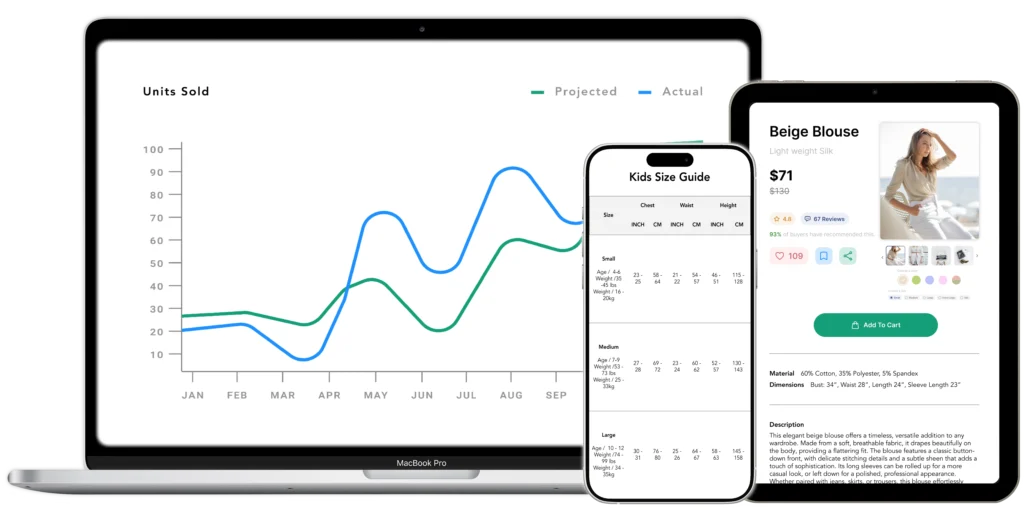What is Product Information Management (PIM)?
A Beginner's Guide
In its simplest form, Product Information Management (PIM) stores, manages and distributes all information related to your products.
Below, we go through everything you need to know about PIM, including its benefits, its history and how PIM can support various industries including textiles, fashion, manufacturing, retail and more.

PIM Explained - What is PIM?
PIM’s main goal is to make sure all your product information is accurate, up-to-date and consistent across all your sales channels. Think descriptions, prices, images, specifications and other important product data, all managed in one, single source of truth.
History of Product Information Management
Pre-digital PIM
Before the 1990s, businesses manually managed product information using catalogues, spreadsheets, and printed materials. Of course, this was feasible for small inventories, but expanding product lines presented many challenges, inconsistencies, errors, and delays.
The journey from ERP to PIM
Brands adopted Enterprise Resource Planning (ERP) systems to centralise and manage various business functions, including product data. However, ERP focused more on internal processes, like supply chain management, than product information distribution.
The birth of PIM
By the early 2000s, there was a growing need for specialised tools for product data, especially as brands were expanding into multiple sales channels, including websites, catalogues, stores, and, later, apps. This resulted in the development of Product Information Management (PIM) systems).
Omnichannel ecommerce
As omnichannel retail strategies gained popularity, brands need to ensure customers receive the same product information and experience regardless of channel. A demand for PIMs to integrate with CRM, DAM and CMS systems began to grow.
PIM today and the future
Today, modern brands require intuitive, accessible and scalable PIM software designed around their team’s needs. Imagine a system that seamlessly integrates with other systems and uses automation and AI to ensure data is infallible across every sales channel. That’s Bombiix.
Pre-digital PIM
Before the 1990s, businesses manually managed product information using catalogues, spreadsheets, and printed materials. Of course, this was feasible for small inventories, but expanding product lines presented many challenges, inconsistencies, errors, and delays.
The journey from ERP to PIM
Brands adopted Enterprise Resource Planning (ERP) systems to centralise and manage various business functions, including product data. However, ERP focused more on internal processes, like supply chain management, than product information distribution.
The birth of PIM
By the early 2000s, there was a growing need for specialised tools for product data, especially as brands were expanding into multiple sales channels, including websites, catalogues, stores, and, later, apps. This resulted in the development of Product Information Management (PIM) systems).
Omnichannel ecommerce
As omnichannel retail strategies gained popularity, brands need to ensure customers receive the same product information and experience regardless of channel. A demand for PIMs to integrate with CRM, DAM and CMS systems began to grow.
PIM today and the future
Today, modern brands require intuitive, accessible and scalable PIM software designed around their team’s needs. Imagine a system that seamlessly integrates with other systems and uses automation and AI to ensure data is infallible across every sales channel. That’s Bombiix.
Benefits of PIM – how can PIM help my brand?
Give customers a better experience
PIM gives you the tools to provide consistent, detailed and accurate product information across all touchpoints, enhancing the customer journey. This leads to fewer returns, greater satisfaction and a more personalised shopping experience
Enhance your team's collaboration
With all your product information in one central hub, your team can easily collaborate across departments. PIM supports transparency and alignment, allowing everyone to work with the most accurate and up-to-date data
Manage multi and omnichannel data
Product information is seamlessly managed across multiple platforms and sales channels. Wherever your customers are shopping – online, in store or via your partners – your product data is always delivered accurately and consistently
Make compliance easier
PIM helps you stay compliant with industry standards and regulations by centralising all the necessary product information. You’ll always have the right data ready to meet legal requirements, reducing the risk of fines or delays
Save time, money and resources
With PIM, so many manual tasks are automated, resulting in significant time savings, cost reduction and better use of company resources
Scale up fast
As your business grows, PIM grows with you. Whether you’re expanding your product line or entering new marketplaces, PIM makes it easy to manage the increased complexity while maintaining high levels of data accuracy
Go to market faster
With PIM, you can launch new products to multiple sales channels, faster because you’re able to quickly distribute accurate information without manually creating and managing product listings
Improve accuracy and consistency
A PIM system helps you reduce errors as it removes the need to manually input product information for all your different sales channels. Not only does PIM reduce workload, but it also builds customer trust and brand credibility
Centralise your data
PIM brings all your product information together in one place. With a single, reliable hub, you and your team spends less time searching and more time focusing on what matters, knowing all your data is always up-to-date
Give customers a better experience
PIM gives you the tools to provide consistent, detailed and accurate product information across all touchpoints, enhancing the customer journey. This leads to fewer returns, greater satisfaction and a more personalised shopping experience
Enhance your team's collaboration
With all your product information in one central hub, your team can easily collaborate across departments. PIM supports transparency and alignment, allowing everyone to work with the most accurate and up-to-date data
Manage multi and omnichannel data
Product information is seamlessly managed across multiple platforms and sales channels. Wherever your customers are shopping – online, in store or via your partners – your product data is always delivered accurately and consistently
Make compliance easier
PIM helps you stay compliant with industry standards and regulations by centralising all the necessary product information. You’ll always have the right data ready to meet legal requirements, reducing the risk of fines or delays
Save time, money and resources
With PIM, so many manual tasks are automated, resulting in significant time savings, cost reduction and better use of company resources
Scale up fast
As your business grows, PIM grows with you. Whether you’re expanding your product line or entering new marketplaces, PIM makes it easy to manage the increased complexity while maintaining high levels of data accuracy
Go to market faster
With PIM, you can launch new products to multiple sales channels, faster because you’re able to quickly distribute accurate information without manually creating and managing product listings
Improve accuracy and consistency
A PIM system helps you reduce errors as it removes the need to manually input product information for all your different sales channels. Not only does PIM reduce workload, but it also builds customer trust and brand credibility
Centralise your data
PIM brings all your product information together in one place. With a single, reliable hub, you and your team spends less time searching and more time focusing on what matters, knowing all your data is always up-to-date
Do I need a PIM system?
PIM for Consumer Goods
PIM acts like the thread that ties your design dreams to delivery reality – streamlining workflows, reducing errors and always keeping you a step ahead in your highly competitive, creative market.
PIM for manufacturers
PIM is your blueprint for success – unifying teams, optimising processes and ensuring your products move seamlessly from concept to completion, saving time and resources every step of the way.
PIM for retail
From trends to tills, PIM gives you the clarity to connect your vision with what lands on the shelves, empowering smarter decisions, faster market launches and a shopping experience your customers can’t resist.
Loved by product people, trusted by..











Get a PIM that places your product team front and centre
From product specifications to marketing descriptions, Bombiix keeps every detail organised and ready for action.
PIM FAQs
Below, we answer some of the most frequently asked questions about PIM
What does PIM stand for?
PIM stands for Product Information Management.
What is the meaning of PIM?
Product Information Management (PIM) is the method of storing, managing and distributing all information related to your products.
Why do I need a PIM?
If you want to ensure accuracy, consistency and compliance of your product information across all channels, while saving time and resources on manual tasks, PIM is for you.
PIM vs ERP
Some people often get PIM (Product Information Management) mixed up with ERP (Enterprise Resource Planning), but they both serve different purposes.
ERP manages core business processes like finance, supply chain and HR, streamlining internal operations. However, PIM focuses on managing and distributing product information across sales channels and is more external-facing.
What are the core functions of PIM?
The core functions of a PIM system include:
- Centralising all your product information
- Publishing consistent product data across all your sales channels
- Ensuring data quality, accuracy, consistency and compliance
- Managing product information in multiple languages, currencies and regions
- Cross-team collaboration for information updates and approvals
What are the benefits of using cloud-based PIM solutions?
Cloud-based PIM solutions offer flexibility, easier scalability, lower upfront costs, and remote accessibility. They allow teams to collaborate across geographies and make it easier to integrate with other cloud applications, ensuring data consistency and real-time updates.
PIM vs DAM
It’s common to confuse PIM (Product Information Management) with DAM (Digital Asset Management), but they serve distinct roles.
PIM centralises and manages product data, focusing on product information for sales channels. On the other hand, DAM organises and stores digital assets like images, videos, and documents used for marketing and branding. PIM and DAM go hand in hand, which is why we offer free PIM and DAM to our PLM customers. See pricing.
PIM vs PXM
PMX (Product Enterprise Management) takes PIM (Product Information Management) to another level, enhancing how your product information is presented to customers, personalising and optimising their experience across different touchpoints.
PIM vs PLM
PIM manages and distributes product data across sales channels, while PLM (Product Lifecycle Management) focuses on managing the entire lifecycle of a product, from initial concept and design to production and end-of-life. PIM and PLM go hand in hand, which is why we offer free PIM and DAM to our PLM customers. See pricing.
PIM vs PDS
PIM centralises and manages product data internally, while PDS (Product Data Syndication) focuses on distributing that product data to various external sales channels and partners, ensuring consistency and accuracy across platforms.
What data can you store in PIM software?
In a PIM system, you can store product data such as names, descriptions, SKUs, prices, images, technical specifications, dimensions, categories, and marketing content. Some also handle digital assets like videos, PDFs, and product manuals.